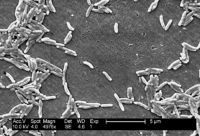Campylobacter fetus subspecies venerealis
| Campylobacter fetus | |
|---|---|
| Phylum | Proteobacteria |
| Class | Epsilon Proteobacteria |
| Order | Campylobacterales |
| Family | Campylobacteraceae |
| Genus | Campylobacter |
| Species | C.fetus |
Introduction
Campylobacter fetus, has the subspecies fetus and venerealis, belonging to the genus Campylobacter. Campylobacter fetus subsp. venerealis causes venereal infection in cattle and infertility in female cattle. Bulls are known as carriers as the bacteria is found in glandular crypts of the bulls prepuce; with no clinical signs. Campylobacter fetus subsp. venerealis is therefore spread by coitus or rarely by artificial insemination. It causes catarrhal inflammation in the female genital tract, temporary infertility and prolonged oestrus cycle. Endometritis prevents implantation until the infection is cleared and causes early embryonic death and occasionally sporadic abortion. The cow may remain infertile for 3-5 months before immunity develops, which then lasts 4-5 years. Effective immunity includes induction of IgA in the vagina and IgG in the uterus. The bacteria may persist in the vagina and be transmitted to bulls.
Diagnosis
A fluorescent antibody test on genital discharges from the bull or cow can be diagnostic. A vaginal mucus agglutination test can be done. An ELISA to IgA antibodies in vaginal mucus after an abortion can be done in the cow, or PCR for detection in semen.
Treatment
Dihydrostreptomycin intrauterine for cows and systemically or topically for bulls. A vaccination of bacterin in oil adjuvant can also be done.
Literature Search
Use these links to find recent scientific publications via CAB Abstracts (log in required unless accessing from a subscribing organisation).
Campylobacter fetus subspecies venerealis
| This article has been peer reviewed but is awaiting expert review. If you would like to help with this, please see more information about expert reviewing. |

